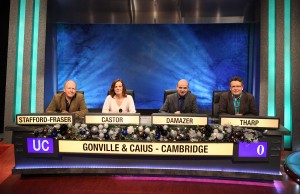 “Television”, said Noel Coward, “is not something one watches. It’s something one appears on.” But it’s quite strange to have done both, having watched myself on University Challenge just now. (See my earlier post.) I’ve been on TV and radio a few times, but they’ve generally been broadcast live, or in other regions, so I’ve seldom had the chance to see myself at the same time as others do. A most bizarre experience.
“Television”, said Noel Coward, “is not something one watches. It’s something one appears on.” But it’s quite strange to have done both, having watched myself on University Challenge just now. (See my earlier post.) I’ve been on TV and radio a few times, but they’ve generally been broadcast live, or in other regions, so I’ve seldom had the chance to see myself at the same time as others do. A most bizarre experience.
Anyway, those who are curious (and in the UK) can see the show here for the next few days. I won’t spoil the suspense, except to say that we didn’t disgrace ourselves. My contribution was rather larger, I hope, than the cameras suggest, but still small. I was, however, blessed with excellent team-mates, and it was all great fun.
A couple of things that might interest regular viewers, that hadn’t previously occurred to me, especially about the starter questions…
The first is that the programme flatters the home viewer. When watching starter questions in the past, I’ve been smugly pleased if I can yell out the answer before the person on screen. But the contestant has had to think of the answer many seconds earlier, press their buzzer, wait for their name to be announced, and then respond. In fact, when you’re on the set, it takes a bit of time to realise that it’s your turn, because you get no feedback on the desk to indicate that you have buzzed first until Roger announces your name. This all takes some time, especially on the (very rare) occasions when he has to say “Gonville & Caius: Stafford-Fraser”! At that point, you have to form some coherent words and speak them out confidently.
The second is that the programme is edited, though very lightly. They try to do it ‘as live’, not least for the benefit of the audience. But there are occasions when contestants responded either a bit faster or a bit slower during the filming than was apparent in the broadcast. Then there are sometimes one or two retakes for technical reasons at the end, so you can be in the unenviable position of having to repeat, earnestly, an answer which you know by then to be false… In general, though, the broadcast is a pretty accurate representation of what it felt like at the time.
Lastly, of course, there are often more people who know the answer than get credit for it, because you usually can’t tell on screen who else is buzzing. I know there were several times where more than one of the Cambridge team, and no doubt several Oxonians too, were pressing their buzzers almost simultaneously, but only one light comes on. Fortunately, Lars Tharp and Mark Damazer were particularly speedy, and they, of course, came from The Right Place.
Anyway, lots of fun, and anyone who’d like to watch any further rounds can find the broadcast times here.
Update: It turns out that at least two of the episodes are available on YouTube, so anyone really keen can see our entry in the first round and the final.
Pah, worst excuse for not recognising Faraday ever.
If you watch it carefully, you may be able to see my finger pressing the button on Faraday… But Lars Tharp got there before me, as usual!
Mehdi Hasan’s (delightful) young daughter told me afterwards, “I knew how to spell ‘woollen’ too!”